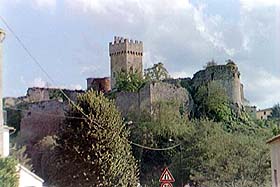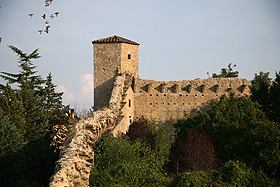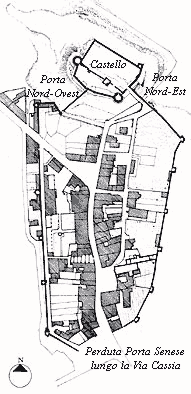Staggia Castle and Town Walls
 |
 |
The castle. |
The walled town of Staggia, with its medieval castle, is in the commune of Poggibonsi, province of Siena. It's easily reachable from the exit 'Colle Valdelsa Sud' of the speedway Florence-Siena.
| La Rocca di Staggia Via dell’Ospedale 2, 53036 Staggia Senese (Poggibonsi - Siena) Contacts: Ph. +39 366 4792092 - info@laroccadistaggia.it - www.laroccadistaggia.it Open every day, Summer opening hours 10-13 / 15-19, Winter 10-17; Guided tours: h. 10-18 (summer); 10-16 (winter); |
» More Photos
» 2003 Restoration Photos
 |
| City map. |
The walls of Staggia join the castle on the northern side and are today almost intact, with the exception of two short interruptions. They are alternated from square or polygonal towers, traces of the watch walk are still visible, particularly the stone brackets of support. The enclosure was gifted of three gates. The Florentine gate (said also of Northwest) and that of Northeast, both next to the castle, are still intact, while the Senese gate sets to South is disappeared, destroyed to permit the widening of the roadway!
The ancient castle has an irregular shape near to the form of a rectangle,
and it rises above a relief. The construction is not orientated in
reference
to the road layout of the walled suburb. The castle is divided in two
enclosures by a curtain at the center the inner ward. This wall is
the
only trace of the first fortification erected by the Soarzi at the
end of 1100. This division, although very diffused in the fortifications
of
other parts of Italy, it's rare to be found in the Tuscan castles.
The enclosure toward the suburb, endowed with two mighty cylindrical
bastionated
towers set to each angle, had the function of residence of the constable.
This part, whose reinforcements goes back certainly to the strengthening
of the 15th century, was erected by the Franzesi at the beginnings
of
14th century. We can still notice some particulars that denote the
refinement of the construction as a coat of arms on the tower to north,
some portals,
elegantly worked windows and a big fireplace set to the inside wall of
the palace. The other, greater, enclosure served for secondary purposes,
for instance as last shelter for the population in case of yielding of
the wall curtain, and it was endowed with square towers similar to those
of the city walls, of which only one has remained today partially intact.
The principal, and unique gate, of the fortification is set in this part
of the castle; through another gate posted in the division wall
was possible to access the greater courtyard. The way of access toward
the main entrance is unique in its kind, at least in Tuscany: it is
reachable
following a perpendicularly ramp that cross the gate of Northeast.
So were created two road levels that made independent the traffic from
and
toward the city from the one of the castle. This urbanistic solution
was for that time great and still actual today!
The castle lies in a state of abandonment. Only the keep has been of restoration
in the past years. The side occupied by the small enclosure is invaded
from the vegetation and with serious danger of collapse. Part of the construction
has been used for long time as deposit of rural materials. This situation
mortifies a fortification for centuries contended between two big medieval
powers as Siena and Florence.
On 10th June 2007 the restored castle was reopened to the public.
| More Photos |
| Back to Homepage |
| Back to Castles Index |